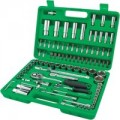Square drive size
The size of the "seat" for which the socket heads included in the package are designed (see below), in other words, the size of the square hole on the back of the head used for installation on a ratchet, wrench or other similar tool. Accordingly, the tool for working with heads supplied in the kit has the same dimensions of the landing square; and in the absence of such tools in the kit, data on the size of the heads will be useful for its selection.
There is a generally accepted standard for these sizes, providing for the designation in fractions of an inch — from 1/4 "to 1". Thanks to this, heads and tools from different sets can be quite compatible — just matching in size is enough. Most often in modern hand sets there are options in 1/4 "and 1/2", a little less often — 3/4" and 3/8". Some sets include several variants of the landing square at once.
Socket heads (6 points)
Number of
hex sockets included in the tool kit.
All end heads are accessories for a collapsible tool; during operation, they are mounted on a ratchet, wrench or other similar device. The head itself has the appearance of a characteristic “cap”, which, during operation, is put on a bolt, nut, etc. This design, among other things, allows you to work with parts located in recesses and some other hard-to-reach places that cannot be reached with open-ended, captive or split keys. And compared to a set of classic socket wrenches, the holder plus socket set takes up much less space, providing almost the same functionality.
As for the 6 faces, this type of socket head is the most famous and widespread, because. most modern nuts and bolts have this shape.
Adapter
An adapter for docking seemingly incompatible elements from a set. For example, socket heads with an unsuitable landing square on a ratchet, screwdriver handle or in a drill driver.
The adapter provides full-fledged work with all the required list of tools from the set.
Extension
The type of extension included with the tool kit.
Extensions refer to "intermediate" devices, if necessary, installed between the main tool (like a screwdriver handle, see above) and the working nozzle. As the name implies, they allow you to increase the length of the working part of the tool — for example, to get to hard-to-reach places. Here are the main options for such devices:
—
Hard. Rigid rod extension. It does not give such freedom of action and the ability to get to hard-to-reach places as flexible (see below), but it is considered more reliable, allows you to develop great efforts (often the same as when working without an extension cord) and even allows the use as an improvised lever. Some rigid extensions may also have a crank function (see above).
—
Flexible. An extension in the form of a flexible tube, usually made of a metal spiral. Such an extension, like a universal joint (see above), allows you to position the nozzle at an angle to the axis of rotation of the main tool — while the range of such angles is much wider (in some cases they can reach 180 °), and the long length and high mobility of the device are even more expands freedom of action. The disadvantage of flexible extensions is less suitability for work with greater efforts than the rigid ones described above.
— Rigid/flexible. This option is indicated for sets equipped with both types of
...extensions described above. This makes it possible to choose an option depending on the specific situation.
If there are several extensions of the same type in the kit, they, usually, differ in the size of the attachment (see "Landing square").Dimensions
The dimensions of the entire set, namely the case, lodgment, cassette, etc. storage accessory (see paragraph above) with tools installed inside. Allows you to understand how much space the model will occupy and whether it can be placed in a complete set in one place or another.
Weight
The total weight of the tool kit. Indicated with a case, stand or other storage/transportation device (see Tool Storage). First of all, you should pay attention to this parameter if you plan to often carry the kit over long distances — the lighter the weight, the easier it will be to do. At the same time, extensive sets inevitably turn out to be weighty.

